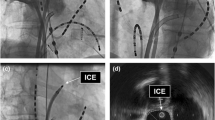Abstract
Background
Surgical ablation techniques using microwave energy are an alternative to catheter based ablation therapy in the treatment of atrial fibrillation (AF). However, little is known about potential procedure-related complications. We investigate, whether there is evidence of pulmonary vein stenosis (PVST) in patients with atrial fibrillation undergoing epicardial microwave ablation.
Methods
14 patients (ten males and four females) with AF and structural heart disease underwent cardiac surgery for the underlying disease and concomitant ablation of AF using microwave energy. In these patients with a mean age of 71 ± 8 years microwave energy was applied epicardially on the beating heart. Ablation was implemented using a flexible microwave tool with a 40 mm long tip to create isolation of the pulmonary veins. Each application was performed with 65 watt for 90 s. Follow-up was performed twice at a mean of 207 ± 73 days and 395 ± 102 days. Patients were evaluated by 12-lead-ECG and echocardiography. Multidetector helical computer tomographic (MDCT) imaging was done in seven patients to show morphology of the pulmonary veins.
Results
On second follow-up 11 patients were seen. ECG showed sinus rhythm in six patients (55 %) and atrial fibrillation in five patients (45%). MDCT showed a moderate pulmonary vein stenosis (50–70%) in one patient. The patient did not suffer from palpitations, dyspnea, angina or syncope.
Conclusions
Epicardial microwave ablation is an accepted treatment of atrial fibrillation. The procedure can be done off-pump on the beating heart. Nevertheless, pulmonary vein stenosis is a possible complication of this procedure, which should be kept in mind and evaluated during the follow-up.




Similar content being viewed by others
References
Kannel, W. B., Wolf, P. A., Benjamin, E. J., & Levy, D. (1998). Prevalence, incidence, prognosis, and predisposing conditions for atrial fibrillation: population-based estimates. The American Journal of Cardiology, 82(8A), 2–9.
Haissaguerre, M., Jais, P., Shah, D. C., Takahashi, A., Hocini, M., Quiniou, G., et al. (1998). Spontaneous initiation of atrial fibrillation by ectopic beats originating in the pulmonary veins. The New England Journal of Medicine, 339(10), 659–666.
Mazzitelli, D., Park, C.H., Park, K.Y., Benetti, F.J., & Lange, R. (2002). Epicardial ablation of atrial fibrillation on the beating heart without cardiopulmonary bypass. The Annals of Thoracic Surgery, 73.
van Brakel, T. J., Bolotin, G., Nifong, L. W., Dekker, A. L., Allessie, M. A., Chitwood, W. R.,. Jr, et al. (2005). Robot-assisted epicardial ablation of the pulmonary veins: is a completed isolation necessary? European Heart Journal, 26(13), 1321–1326.
Taylor, G. W., Kay, G. N., Zheng, X., Bishop, S., & Ideker, R. E. (2000). Pathological effects of extensive radiofrequency energy applications in the pulmonary veins in dogs. Circulation, 101(14), 1736–1742.
Thomas, S. P., Guy, D. J., Boyd, A. C., Eipper, V. E., Ross, D. L., & Chard, R. B. (2003). Comparison of epicardial and endocardial linear ablation using handheld probes. The Annals of Thoracic Surgery, 75(2), 543–548.
Robbins, I. M., Colvin, E. V., Doyle, T. P., Kemp, W. E., Loyd, J. E., McMahon, W. S., et al. (1998). Pulmonary vein stenosis after catheter ablation of atrial fibrillation. Circulation, 98(17), 1769–1775.
Gillinov, A. M., Smedira, N. G., & Cosgrove, D. M.,. I. I. I. (2002). Microwave ablation of atrial fibrillation during mitral valve operations. The Annals of Thoracic Surgery, 74(4), 1259–1261.
Rahmanian, P. B., Castillo, J. G., Mehta, D., Adams, D. H., & Filsoufi, F. (2008). Epicardial pulmonary vein isolation: a long-term histologic and imaging animal study comparing cryothermy versus radiofrequency. The Annals of Thoracic Surgery, 86(3), 849–856.
Mohr, F. W., Fabricius, A. M., Falk, V., Autschbach, R., Doll, N., Von Oppell, U., et al. (2002). Curative treatment of atrial fibrillation with intraoperative radiofrequency ablation: short-term and midterm results. The Journal of Thoracic and Cardiovascular Surgery, 123(5), 919–927.
Aupperle, H., Doll, N., Walther, T., Kornherr, P., Ullmann, C., Schoon, H. A., et al. (2005). Ablation of atrial fibrillation and esophageal injury: effects of energy source and ablation technique. The Journal of Thoracic and Cardiovascular Surgery, 130(6), 1549–1554.
Maessen, J. G., Nijs, J. F., Smeets, J. L., Vainer, J., & Mochtar, B. (2002). Beating-heart surgical treatment of atrial fibrillation with microwave ablation. The Annals of Thoracic Surgery, 74(4), S1307–S1311.
Wonnell, T. L., Stauffer, P. R., & Langberg, J. J. (1992). Evaluation of microwave and radio frequency catheter ablation in a myocardium-equivalent phantom model. IEEE Transactions on Bio-Medical Engineering, 39(10), 1086–1095.
Spray, T. L., & Bridges, N. D. (1999). Surgical management of congenital and acquired pulmonary vein stenosis. Seminars in Thoracic and Cardiovascular Surgery. Pediatric Cardiac Surgery Annual, 2, 177–188.
Author information
Authors and Affiliations
Corresponding author
Rights and permissions
About this article
Cite this article
von Bary, C., Mazzitelli, D., Nöbauer, C. et al. Is there an evidence of pulmonary vein stenosis following epicardial microwave ablation of atrial fibrillation?. J Interv Card Electrophysiol 25, 193–197 (2009). https://doi.org/10.1007/s10840-009-9366-y
Received:
Accepted:
Published:
Issue Date:
DOI: https://doi.org/10.1007/s10840-009-9366-y




